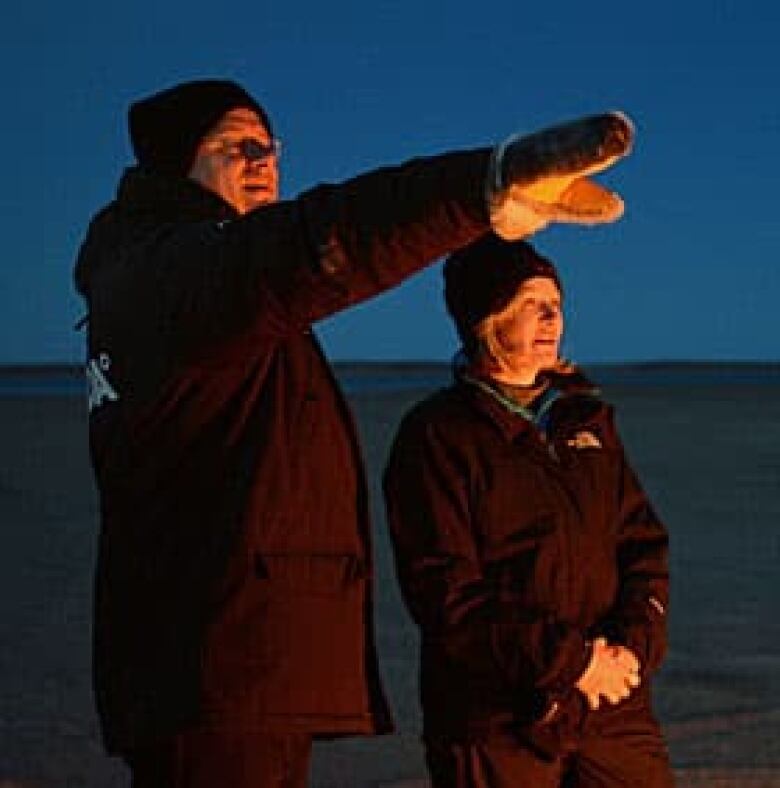Harper goes target shooting with Canadian Rangers in Arctic
PM tries out vintage rifles used by Northern reservists
Stephen Harper took up arms albeit antique ones for some target practice on the Arctic tundra and plied the frigid waters of the Northwest Passage in a sovereignty patrol meant to show solidarity with Canadian Rangers.
Both the prime minister and newly appointed Defence Minister Rob Nicholson tried their hand at firing the 1950s-era Lee Enfield rifles that are standard-issue weapons for the aboriginal reservists who comprise the Rangers.
- North support more than just 'trickle down,' Harper says
- Harper's Northern tour is about politics as much as policy
"It was an honour to patrol with the Rangers ... as they work to defend our territory from potential threats and emergencies and keep our North strong, secure and free," the prime minister said in a statement.

Harper clearly relished the bonding exercise and during target practice he fired from several different positions, including prone on the ground, sniper-style.
Shots from the rifle demonstration reverberated for kilometres over the empty limestone and sand landscape.
But it was as much a political statement as a chance to share the rigours of Northern life for a prime minister whose mantra has been to assert and defend Canada's claim to the Arctic.
"Canada has a choice when it comes to defending our sovereignty over the Arctic. We either use it or lose it," Harper said in a July 2007 speech that helped lay the foundation for the Conservative government's northern strategy.
The tough rhetoric and thundering military photo-ops, however, have gradually faded with each successive summer tour of the Arctic, which Harper has undertaken religiously since becoming prime minister.
Harpers camp with entourage
His latest trip has led him to this wide-open, chilly nook of Nunavut's King William Island, infamous as the potential resting place of the lost Franklin Expedition of the 1800s.
With four cabinet members in tow, Harper and his outdoors-loving wife set up camp on a remote stretch of beach about 20 kilometres from Gjoa Haven, birthplace of Environment Minister Leona Aglukkaq.
On Wednesday, Harper attended an event at the local community centre before heading out to visit the Canadian Coast Guard vessel Sir Wilfrid Laurier for an update on the efforts to locate Franklin Expedition evidence.
It was a far cry from the previous day's events,when a group of enthusiastic Rangers helped him build an inukshuk, the stone landmark synonymous with the Inuit. They also showed him how to erect a traditional tundra shelter made of animal hide.

As the sun set close to midnight, Harper inspected drying Arctic char hung on string between wooden posts, and watched a demonstration of the lighting of qulliq, an Inuit oil lamp that is set ablaze using the spark of two flint rocks.
National Defence spends $38 million annually on the Ranger program, which on Wednesday marked the induction of its 5,000th member.
A recently released defence science report on the Arctic noted the reserve force does not have training in air-mobile and water-borne operations.
Maj. Andre Salloum said future specialized training is being considered, but it "is in the planning stages."
Rifle replacements starting in 2016
The army has been trying for years to replace the aging Lee Enfields, which are updated Second World War-vintage versions of the classic rifles first introduced to the British Army in 1895.
The fact that they don't freeze up or jam in the Arctic is part of their charm.
At a stop in Hay River, N.W.T., prior to arriving in Nunavut, Harper acknowledged National Defence was still looking for an appropriate replacement.
"I am told there is no difficulty in servicing the weapons at this time, but this is a concern and we believe it is time," he said. "The Department of National Defence is in the process of scoping out the program for replacement and I expect that to happen over the next few years."
The weapons were purchased in the 1950s; a statement from Harper's office on Wednesday said the government plans to begin replacing them in 2016.
In 2011, Public Works put out a call to companies for specifications for 10,000 replacement rifles, but defence industry sources have said that the program has been held up over concern about who holds the design rights on certain weapons.
[IMAGEGALLERY galleryid=4902 size=large]
Corrections
- An earlier version of this story said the rifles were First World War-vintage. In fact, the rifles were purchased in the 1950s.Aug 21, 2013 7:05 PM ET













_(720p).jpg)


 OFFICIAL HD MUSIC VIDEO.jpg)
.jpg)



























































































